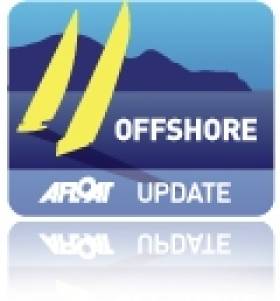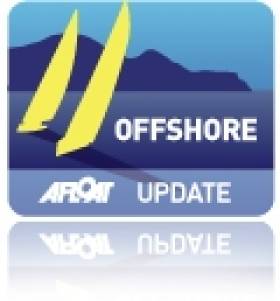Displaying items by tag: Hugo Boss
Alex Thomson Explains Dismasting Incident That Took Hugo Boss Out Of Barcelona World Race
#BarcelonaWorldRace - "One of the most painful experiences of my sporting life" is how Alex Thomson describes the dismasting incident on the IMOCA 60 Hugo Boss that took him and Alex Pepe out of the Barcelona World Race.
As previously reported on Afloat.ie, the pair were in the lead of the global two-man-crew offshore challenge when they lost their rig on Wednesday evening (14 January) some 370 nautical miles off the Brazil coast.
Speaking from the South Atlantic yesterday (15 January) en route to Salvador, Brazil, Thomson outlined exactly what happened on board their monohull.
“At about 9pm Pepe and I were doing a sail change in 18 knots of wind. As we dropped one of our headsails, the furler broke and flew into the air.
"For a few seconds the mast hovered, before falling backwards and into the water. Pepe reacted quickly and we cut the rest away, losing the mast, boom and rigging.
"Of course we are devastated and disappointed. As offshore ocean racing sailors this is a peril of our sport, but it is still painful."
Though the pair are now out of the race, their focus is entirely on attempting to "assess and analyse the problem and learn from this, but we will remain ever determined and resilient to come back stronger and succeed.”
See more on this story at the Alex Thomson Racing website HERE.
Barcelona World Race Leader 'Hugo Boss' Dismasted Off Brazil
#barcelonaworldrace – 14 days into the race and 2 race records broken, Alex & Pepe were making brilliant progress in the Barcelona World race until HUGO BOSS lost their rig yesterday evening at 21.02 GMT, 370 nautical miles off the coast of Brazil.
Alex Thomson, a frequent visitor to Ireland, and Pepe Ribes, skippers of the IMOCA 60 HUGO BOSS, which was leading the Barcelona World Race, this evening lost their mast overboard at 21.02 GMT. The yacht was reaching in moderate conditions when there is reported to have been a rigging failure and the mast fell over.
Briton Thomson, 40, and Spaniard Ribes, 43 will now cease racing in the Barcelona World Race 2014 -2015. The skippers and the shore team are currently evaluating how to get the boat to the nearest landfall, which is likely to be Salvador de Bahia in Brazil which is a significant distance from the boat's current position.
Below posted only yesterday on facebook hours before the dismasting, a look back at the 2nd week of The Barcelona World Race onboard HUGO BOSS as Alex & Pepe hold onto their lead over the rest of the fleet:
Hugo Boss Lead in Barcelona World Race
#bwr_2014 – In the Barcelona World Race British entry Hugo Boss have consolidated over the course of last night, gybing back from their position in the east of the pack, to line up in the front of their rivals with a lead cut to just over 11 miles this morning. As well as their desire not to pin themselves out to the west, the trade winds were a little quieter for them so close to the African coast, and so the move back to the west made sense.
Cheminées Pooujoulat have been quick through the night and are back up to third at about eight miles up on GAES Centros Auditivos. Hugo Boss gybed just in front of Neutrogena which is now second.
The east-west separation between Hugo Boss' course and that of GAES Centros Auditivos is 30 miles and Anna Corbella and Gérard Marin are slightly faster than Alex Thomson and Pepe Ribes, at just on 17.8kts.
The fast pace should continue for the coming days, probably until Friday. The next strategic decision will be at the Cape Verde islands tomorrow when they must decide how to pass this island group. To he west there is slightly more wind on the forecast, but the same situation as the Canary Island holds true again, but there will be up to 30kts of NE'ly trades to ensure sailing will be fast and furious.
The motorway south is well and truly working for the fleet. The leaders are a likely to gybe west again this evening as the breeze appears lighter close to the Mauritania coast. But up ahead the Doldrums do not look too active at all and a reasonably easy passage through to the Equator does seem likely, the overall race pace very similar to the 2010-2011 edition.
Once again conditions through the night will have been excellent with the full moon and little or no cloud cover, temperatures are very pleasant.
One Planet One Ocean remain in good wind pressure on their course, but they too will have to adjust to the west and when they settle on their course south then the speed differential between their older boat and the newer generations will start to really show and they might expect to lose 40-50 miles a day. Correspondingly We Are Water can start to see steady gains on their nearest rivals once they are on the fast route south.
Spirit of Hungary had some good, faster sailing through the night but it will only really start to get into the stronger trade winds today, a chance to enjoy the speed potential of their newest IMOCA 60.
#hugoboss – Alex Thomspon's Hugo Boss Yacht that called into Cork Harbour marina en route to New York from Southampton in late April has broken its mast during the Atlantic Crossing.
Last Friday morning whilst sailing upwind at 25 knots, the team progress to New York has been interrupted when their mast broke. The reason for the broken mast is currently unknown; however, the on-board team, which includes skippers Alex Thomson, Pepe Ribes, Ryan Breymaier and crewmember, Willy Altadill are all safe and have stabilized the mast. Alex has reported that there is no damage to the boat or sails and they will continue to Newport, Rhode Island. T
The broken section has been secured and the boat is able to sail with the remaining mast and they are on route to Newport RI. At the moment our intention is to make a suitable repair to allow Pepe and Ryan to take part in the New York to Barcelona Race race but until the boat is in port and fully assessed we cannot finalise our plans.
The team website says: 'the mast was broken above the top spreader. We are relieved to announce that the four crew members on-board are safe and we have notified their families and our sponsors'.
In April, the Open 60 made a surprise visit to Cork Harbour Marina in Monkstown Bay, giving some 50 local junior sailors a tour of the vessel - and hopefully inspiring their future in offshore racing.
Skipper Alex Thomson said he and his crew were not far off Land's End in Cornwall after a leak discovered in the starboard ballast tank required overnight repairs.
But rather than sail back to Falmouth, Thomson reckoned they could find a suitable deep-water berth on Ireland's south coast.
A few phone calls later from the team's business manager (and Corkonian) Stuart Hosford, and they had a place waiting for them in Monkstown Bay, which can boast of over eight metres of water at low tide - more than enough for a vessel of Hugo Boss' stature.
Hugo Boss Open 60 Stops Off At Cork Harbour Marina
#Offshore - The Open 60 Hugo Boss made a surprise visit to Cork Harbour Marina in Monkstown Bay at the weekend, giving some 50 local junior sailors a tour of the vessel - and hopefully inspiring their future in offshore racing.
Skipper Alex Thomson said he and his crew were not far off Land's End in Cornwall after a leak discovered in the starboard ballast tank required overnight repairs.
But rather than sail back to Falmouth, Thomson reckoned they could find a suitable deep-water berth on Ireland's south coast.
A few phone calls later from the team's business manager (and Corkonian) Stuart Hosford, and they had a place waiting for them in Monkstown Bay, which can boast of over eight metres of water at low tide - more than enough for a vessel of Hugo Boss' stature.
"We could not believe it when we found a welcoming committee on the dock when we arrived at 3.30am on Saturday," said Thomson.
"The marina owner, James O’Brien, was there to help us dock and some Monkstown Bay Sailing Club members took us up the Boson Guest House, where they had reserved rooms for us whilst we were still at sea."
After a hearty cooked breakfast, and a free lunch from Hassett's Bakery in Carrigaline, Thomson and crew found they were the "star attraction" in Monkstown "with a steady flow of visitors who just wanted to see the boat while we worked on it".
When the team hauled up the mainsail to check the rigging they inadvertently made a new addition to Cork Harbour's skyline, even blocking out the view of Cobh Cathedral!
But it wasn't all work for Thomson and company, as the skipper said Sandy Rimmington and other club members were on hand to help with repairs "and we were able to relax in the club on Sunday night, drinking stout until all hours with local sailors and the survivors from watching the Munster match in the afternoon."
Before the Open 60 departed yesterday (28 April) en route across the Atlantic to New York, Thomson described their impromptu visit to Cork Harbour as "one of those serendipitous incidents. We were lucky to be near Monkstown when we ran into a problem, rather than mid-Atlantic. What a great place to have to visit by accident!"
He also expressed his hope that "the next phase of development for the marina will go ahead and yachts such as ourselves will be able to use the facilities again in the future.
"With this development in place, Monkstown and Cork Harbour will be much more attractive to play host to a major international race. It is ideally located as a base and destination for offshore racing."
Knox-Johnston in Search for Ten Skippers
Sailing legend Sir Robin Knox-Johnston has launched his latest search for ten exceptional skippers to lead the internationally sponsored teams in the next edition of the Clipper Round the World Yacht Race. Clipper 11-12 will start form the UK in August next year and on board the matched fleet of stripped down 68-foot ocean racing yachts will be teams of novice crews representing all walks of life. The only professional sailor on board, the skipper has the challenge of turning such a diverse mix of people into a finely-honed racing team and it's one that professionals understand can deliver valuable benefits to their CV.
Sir Robin says, "Tackling this unique challenge, with its roaring gales and towering seas, as well as the frustrations of tricky calm spells, is no mean feat. The skippers we are looking for need to be up to the challenge of competitively racing our 68-foot yachts around the world with a non-professional crew onboard.
"The successful individuals must have the ability to draw the line between competitiveness and safety, whilst also motivating a sometimes exhausted crew into an enthusiastic and committed team.
"Leading a team of novice sailors in a race around the world is one of the hardest and most challenging jobs that any skipper could ever undertake and not everybody is up to this challenge."
Successful candidates will skipper one of the Dubois designed Clipper 68s and must also have an understanding of the commercial and media demands of this high-profile global event which can help launch a skipper's career.
The youngest skipper to win the Clipper Race was Alex Thomson who was just 25 when he led a team in the 1998 edition of the race. Twelve years later and Alex is getting his brand new IMOCA Open 60, Hugo Boss, ready for the double-handed Barcelona World Race which starts in December. The Gosport based sailor is widely considered to be one of the UK's top solo ocean racers and once he has returned for the Barcelona World Race he will be hoping to fulfil his dream by becoming the first non-Frenchman to win the Vendee Globe.
Other Clipper skippers who have gone on to secure sponsorship for solo ocean racing include Hannah Jenner who skippered in both the Clipper 07-08 and 09-10 Races. Hannah will be taking part in the Global Ocean Race next year, a 30,000-mile double-handed race around the world. Similarly Clipper 09-10 skipper, Chris Stanmore-Major is about to set off on his 2,500-mile qualifying passage for the VELUX 5 OCEANS race onboard his Open 60 Spartan having secured sponsorship to take part in what is deemed to be 'The Ultimate Solo Challenge'.
Interested skippers need to have the correct level of qualifications, including an MCA approved Ocean Yachtmaster. They need to be excellent sailors who put seamanship and safety first, have a proven track record in sail training and can demonstrate that they are strong team leaders.
Clipper Race Director Joff Bailey, skipper of New York in the Clipper 05-06 Race, says, "Being a race skipper in the Clipper Round the World Yacht Race was one of the hardest jobs I have ever done. However, the reward and satisfaction when you see the crew that you have trained react to situations as though they were full-time professionals and the look of achievement on their faces when they have crossed an ocean and finished a race, is the best high in the world."
If you think you are up for the challenge and have the right characteristics and experience contact Sir Robin by email on [email protected] to request an application form.



































































